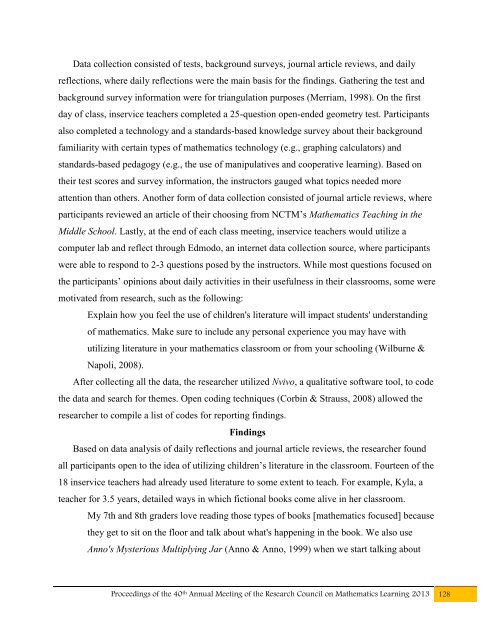2013 Conference Proceedings - University of Nevada, Las Vegas
2013 Conference Proceedings - University of Nevada, Las Vegas
2013 Conference Proceedings - University of Nevada, Las Vegas
- No tags were found...
You also want an ePaper? Increase the reach of your titles
YUMPU automatically turns print PDFs into web optimized ePapers that Google loves.
Data collection consisted <strong>of</strong> tests, background surveys, journal article reviews, and dailyreflections, where daily reflections were the main basis for the findings. Gathering the test andbackground survey information were for triangulation purposes (Merriam, 1998). On the firstday <strong>of</strong> class, inservice teachers completed a 25-question open-ended geometry test. Participantsalso completed a technology and a standards-based knowledge survey about their backgroundfamiliarity with certain types <strong>of</strong> mathematics technology (e.g., graphing calculators) andstandards-based pedagogy (e.g., the use <strong>of</strong> manipulatives and cooperative learning). Based ontheir test scores and survey information, the instructors gauged what topics needed moreattention than others. Another form <strong>of</strong> data collection consisted <strong>of</strong> journal article reviews, whereparticipants reviewed an article <strong>of</strong> their choosing from NCTM’s Mathematics Teaching in theMiddle School. <strong>Las</strong>tly, at the end <strong>of</strong> each class meeting, inservice teachers would utilize acomputer lab and reflect through Edmodo, an internet data collection source, where participantswere able to respond to 2-3 questions posed by the instructors. While most questions focused onthe participants’ opinions about daily activities in their usefulness in their classrooms, some weremotivated from research, such as the following:Explain how you feel the use <strong>of</strong> children's literature will impact students' understanding<strong>of</strong> mathematics. Make sure to include any personal experience you may have withutilizing literature in your mathematics classroom or from your schooling (Wilburne &Napoli, 2008).After collecting all the data, the researcher utilized Nvivo, a qualitative s<strong>of</strong>tware tool, to codethe data and search for themes. Open coding techniques (Corbin & Strauss, 2008) allowed theresearcher to compile a list <strong>of</strong> codes for reporting findings.FindingsBased on data analysis <strong>of</strong> daily reflections and journal article reviews, the researcher foundall participants open to the idea <strong>of</strong> utilizing children’s literature in the classroom. Fourteen <strong>of</strong> the18 inservice teachers had already used literature to some extent to teach. For example, Kyla, ateacher for 3.5 years, detailed ways in which fictional books come alive in her classroom.My 7th and 8th graders love reading those types <strong>of</strong> books [mathematics focused] becausethey get to sit on the floor and talk about what's happening in the book. We also useAnno's Mysterious Multiplying Jar (Anno & Anno, 1999) when we start talking about<strong>Proceedings</strong> <strong>of</strong> the 40 th Annual Meeting <strong>of</strong> the Research Council on Mathematics Learning <strong>2013</strong> 128




